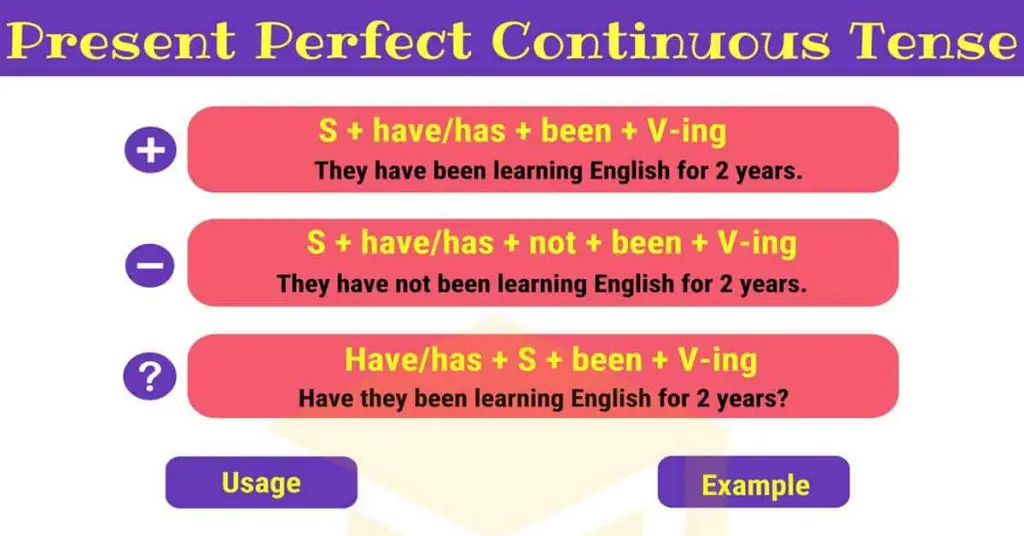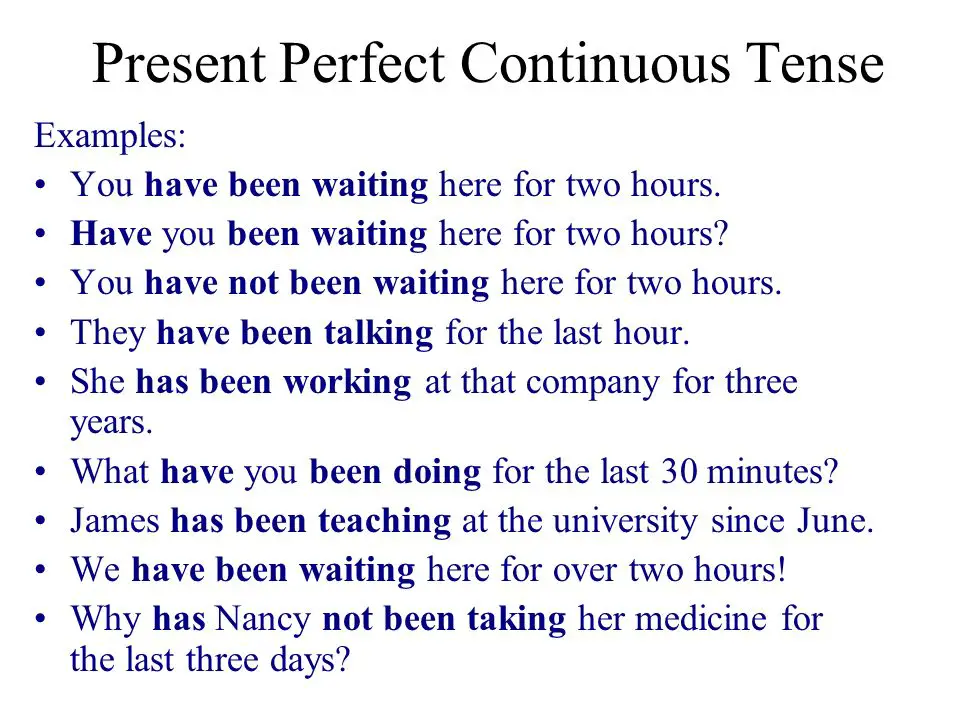The present perfect continuous tense is also known as the present perfect progressive tense or the present perfect progressive aspect. It is a verb tense that is used to express an ongoing action or a continuous action that started in the past and is still happening in the present.
its structures in English. Please follow the list about Structure of Present Perfect Continuous Tense;

1. Introduction to Present Perfect Continuous Tense.
The present perfect continuous tense (or present continuous) is an English verb tense that uses the present tense of ‘to be’ (I am, you are, he is, we are, they are) and the past participle (loved, read, written, gone, etc.).
2. Definition of Present Perfect Continuous Tense
The present perfect continuous tense is used to refer to an action that began in the past and has been continuing at the point of reference. It is more specific than the present perfect tense and more general than the present perfect tense. It is used to talk about actions that started in the past and continue to the present.
3. How to make sentences in Present Perfect Continuous Tense?
Making sentences in Present Perfect Continuous Tense is fairly easy, as long as you understand how to use it. Present Perfect Continuous Tense is used to express an action that started in the past and continues to the present (or not over yet). You will usually use the verb “have” in this sense, as in “I have been reading this book for the last half hour”. Here are some examples:
4. Examples of present perfect continuous tense
Present Perfect Continuous Tense is used to show an action that started in the past and has continued up to the present time. For example, I have been learning English for the last four years. Here the action of learning has not finished yet. The present perfect continuous tense is widely used in weather reports to show that the present weather situation is different from the weather of the past. For example, It has been raining since yesterday.

5. How to use present perfect continuous tense?
Present perfect continuous tense is used to express the temporal duration of an action which started in the past and still continues in present. Present perfect continuous tense is used with two-time expressions whereas usually present perfect tense is used alone. Present perfect continuous tense is made from three words: auxiliary verb ‘have’ + present participle form of the verb + ‘for’ + time duration expression.
6. How is it different from Present Perfect Tense?
In the present perfect tense, the time is not clear. It could be in the present or past. For example, She has gone to India. Here, we don’t know when she went to India. She might have gone to India a year ago. For example, He has been in hospital for the past five weeks. Here, we don’t know for how long he has been in hospital. He might have been in hospital for five days. The present perfect tense is used for the last time when the time is not clear. Present perfect simple tense is used for present time when we are certain about the time.
7. Usage of Present Perfect Continuous Tense.?
Present Perfect Continuous Tense is practically interchangeable with Present Perfect Tense. It is used in two instances. First, when the duration of action is unknown.
For Example:
1. “I have been to New Delhi many times.”
2. “Since I have been here,
3. I have never seen you.”
4. “I have lived here for several years.”
8. The Structures of Present Perfect Continuous/Progressive Tense?
Present perfect continuous is used to describe an action that has been going on since the past and is continuing in the present or will continue in the future. We do not use present perfect continuous to refer to any specific time but it is generalized. For example Present perfect continuous: I have been working since morning. It is generalized because we do not know exact time when you have been working. Present perfect continuous is formed with have/has+ been + present participle of a verb. For regular verbs have/has+ been + present participle of a verb is the same. For example: write/has been + writing , think/has been + thinking , read/ has been + reading . For irregular verbs have/has + been + present participle of a verb is different. For example: come/has been + coming , stop/has been + stopping , break/has been + breaking
| POSITIVE (+) | NEGATIVE (-) | QUESTION (?) |
| I have been starting | I have not (haven’t) been starting | Have I been starting |
| You have been starting | You have not (haven’t) been starting | Have you been starting |
| He has been starting | He has not (hasn’t) been starting | Has she been starting |
| She has been starting | She has not (hasn’t) been starting | Has he been starting |
| It has been starting | It has not (hasn’t) been starting | Has it been starting |
| We have been starting | We have not (haven’t) been starting | Have we been starting |
| You have been starting | You have not (haven’t) been starting | Have you been starting |
| They have been starting | They have not (haven’t) been starting | Have they been starting |
9. Examples of positive sentences?
Positive Sentences ( Subj + HAVE/HAS+ BEEN + Ving )
Examples:
1. There are more than 850 miles of hiking trails in the Great Smoky Mountains.
2. She loves to write short stories in the local coffee shop.
3. Yesterday, he traded in his Android for an iPhone.
4. You have been smoking.
5. He has been walking.
6. She has been singing a song.
7. The athlete has been running for a trophy.
8. I have been traveling to this country for four days.
10. Examples of question sentences.
Question sentences can be used in all types of situations, including both oral and written communication. They often seem like a better alternative to statements in certain situations. Below are some examples of question sentences.
- When will you visit your moms?
- Where do you live?
- Where shall we go?
- Why haven’t you started studying?
- When did you finish your school?
- Where in the world did I leave my phone?
- Who do you love, you can tell us?
- Whose book did you bring me?
Conclusion
So that now you are clear with the uses of the simple present tense, why don’t you comment and share some examples with us
In this article, we have tried to explain the structure of the present perfect continuous tense. Present Perfect Continuous is used to show something that started in the past and has continued up to the present time. It is also used to talk about an action that is happening at the moment. and you can also check other tenses